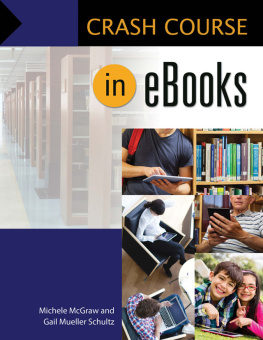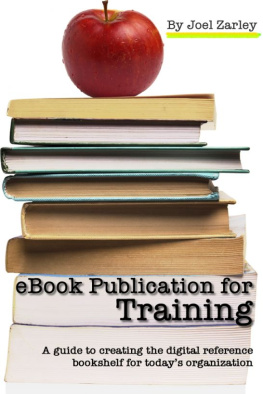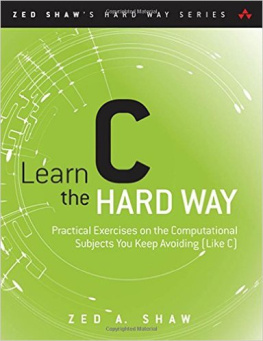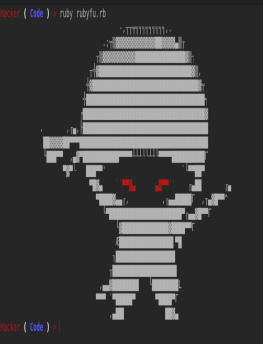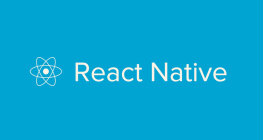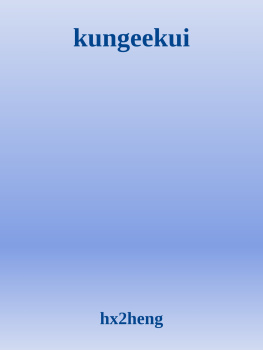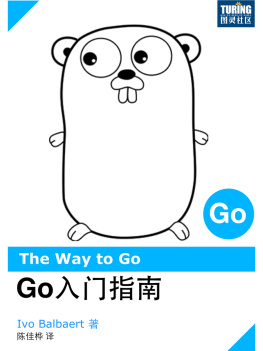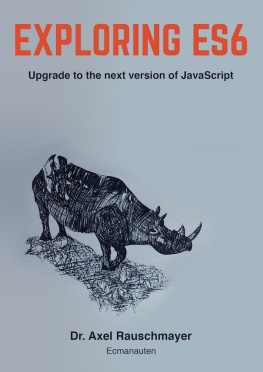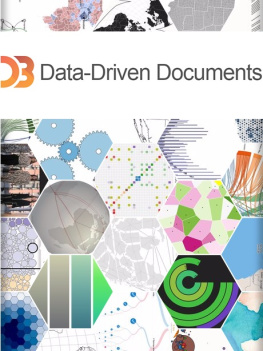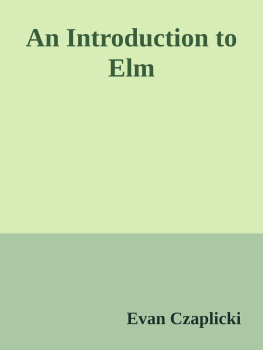Crash Course in eBooks
Recent Titles in
Libraries Unlimited Crash Course Series
Crash Course in Strategic Planning
Stephen A. Matthews and Kimberly D. Matthews
Crash Course in Gaming
Suellen S. Adams
Crash Course in Dealing with Difficult Library Customers
Shelley E. Mosley, Dennis C. Tucker, and Sandra Van Winkle
Crash Course in Children's Services, Second Edition
Penny Peck
Crash Course in Collection Development, Second Edition
Wayne Disher
Crash Course in Marketing for Libraries, Second Edition
Susan W. Alman and Sara Gillespie Swanson
Crash Course in Readers' Advisory
Cynthia Orr
Crash Course in Storytime Fundamentals, Second Edition
Penny Peck
Crash Course in Basic Cataloging with RDA
Heather Lea Moulaison and Raegan Wiechert
Crash Course in Weeding Library Collections
Francisca Goldsmith
Crash Course in Technology Planning
Christopher D. Brown
Crash Course in Library Budgeting and Finance
Glen E. Holt and Leslie E. Holt
Crash Course in eBooks
Michele McGraw and Gail Mueller Schultz
Crash Course
Copyright 2016 by Michele McGraw and Gail Mueller Schultz
All rights reserved. No part of this publication may be reproduced, stored in a retrieval system, or transmitted, in any form or by any means, electronic, mechanical, photocopying, recording, or otherwise, except for the inclusion of brief quotations in a review, without prior permission in writing from the publisher.
Crash Course in eBooks
Library of Congress Cataloging in Publication Control Number: 2016030068
ISBN: 978-1-61069-862-7
EISBN: 978-1-61069-863-4
20 19 18 17 16 1 2 3 4 5
This book is also available as an eBook.
Libraries Unlimited
An Imprint of ABC-CLIO, LLC
ABC-CLIO, LLC
130 Cremona Drive, P.O. Box 1911
Santa Barbara, California 93116-1911
www.abc-clio.com
This book is printed on acid-free paper 
Manufactured in the United States of America
Contents
Welcome to Crash Course in eBooks . We know this is an exciting and rapidly changing time for libraries. Our goal in writing this book is to help you and your library get started in offering eBooks to your patrons or take steps to expand your eBook collection and service.
We know that there is no "one-size-fits-all" solution that is best for every library system. While we work for a large public library system, our goal for this book is to provide a helpful roadmap for libraries to make the best decisions regardless of the size of the community that they serve. This book presents questions, explanations, and examples. We believe that the same questions apply to systems of all sizes but the answers will vary based on the needs of the individual systems.
We also hope that this book will be useful to library systems that already offer eBooks by providing a data-based method to improve current eBook service. Many libraries with existing eBook collections want to upgrade by adding additional vendors, expanding eBook offerings to include other collections (e.g., comics) providing new ways for their patrons to access their collections, or integrating APIs into your catalog. We hope that this book will help library staff make the best decisions for their institutions, and facilitate development of the best possible eBook collections for the customers that they serve.
Chapter
Why Should You Offer eBooks?
After several false starts, eBooks are here to stay. As you start or expand your eBook collection, it is helpful to look back on some of the history of eBook technology, as well as the path libraries and readers have taken to adopt eBooks. You don't need to have an exhaustive knowledge of the history of online format changes or old eReader manufacturers to manage an eBook collection. However, having a basic understanding of how eBooks have been developed for the general consumer provides the context for the challenges libraries face in delivering eBook services to patrons. Providing eBooks to patrons is more challenging than selling eBooks to consumers. In addition, a look through the history of eBook technology highlights the fact that not only eBook services continue to be in a place of change and transition, but reader's needs and expectations are as well.
When the first eBook appeared is difficult to pinpoint with certainty. Many of the differences of opinion on this topic come from different definitions of what an eBook is, since the tools and formats people used to access early online reading options varied widely. Early versions of eBooks were often called "online books" or "electronic books." These were digitized versions of titles that could be read online or downloaded onto desktop computers. Sometimes these online books could be transferred onto other devices, but that was not always the case. The primary reading experience was on a desktop computer. The reading experience did not feature much functionality beyond the basic ability to read the text of the book. For instance, it did not include many, or at times any, of the options that readers today expect. There were seldom options to adjust font size or type, to add bookmarking, note taking, or any of the other reading features we now expect in an eBook experience. But these first online books served their purpose well. If online, the books could be shared widely via an Internet connection and updated constantly. These early formats are still being used for some types of materials, and online books helped open the door to the eBooks we see today.
The first possibility for libraries to explore eBooks was in the 1990s, when the first dedicated eReaders were introduced. The Rocket eBook and the SoftBook Reader were two of the first commercially available eReaders marketed to consumers in the late 1990s. These eReaders had much of the basic functionality that we expect in a modern eReader. They were portable, although they were much thicker and heavier than today's eReaders and similar devices. And they had the capacity to store multiple eBooks. But while today's eReaders can store thousands of eBooks, these first eReaders had a capacity of around 10 books, usually without illustrations and images (http://www.gutenbergnews.org/20110716/eBooks-1998-the-first-eBook-readers/). In addition, the content and delivery platforms for these first eBooks were not highly developed. Some publishers had content available through online bookstores, but there was not enough interesting content to grab the attention of the general consumer. At this point in time, the major U.S. publishers were not producing an eBook version all of their new releases or best sellers to be sold in online bookstores. It was not until the 2000s that the right pieces came together for the general public to start embracing eBooks. The access at that time was primarily through dedicated eReaders, but smaller devices like tablets and cellphones were available with the ability to serve as an eReader as well. In addition, improved content and access management arrived, and mainstream publishers began responding with digital content, both with new releases and by digitizing their backlist. And finally the digital protection was developed for the publishers and content creators. The digital protection makes it possible for the consumer to access and use the eBook. Perhaps more importantly to the publishers and creators, digital protection allowed publishers to limit the access to only the person who had purchased or otherwise had rights to access the eBook. We'll talk more about digital protection later in the book.

